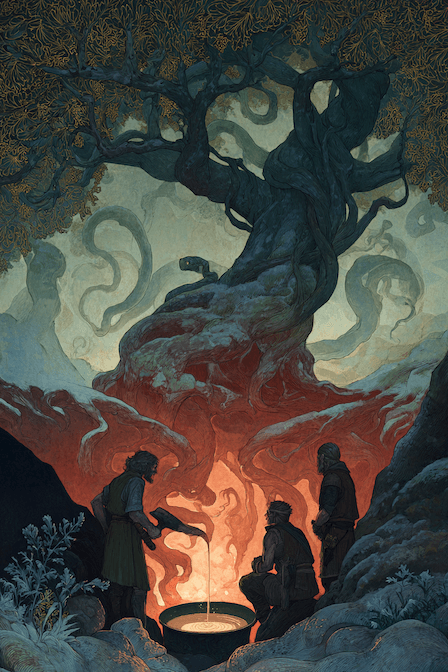Poetic Edda
Also known as: Elder Edda, Sæmundar Edda, Eddaic Poems, Lays of the Gods and Heroes


A medieval Icelandic collection of mythological and heroic poems preserving pre-Christian Norse cosmology, gods, and legendary heroes. It ranges from creation to Ragnarök and from Odin’s runic wisdom to the tragic Völsung cycle.
Description
The Poetic Edda gathers anonymous alliterative lays on the Norse gods and on Germanic heroes. The mythological poems outline the cosmos from Ymir’s shaping to Ragnarök, include contests of wisdom, catalogues of divine lore, ritual maxims, and comic quarrels. The heroic section preserves the Völsung-Nibelung legends: Sigurd’s slaying of Fafnir, Brynhild’s awakening, the tragic fates of Gunnar, Högni, and Gudrun, and the vengeance of Hamdir and Sörli. Compiled in 13th-century Iceland yet drawing on earlier oral tradition, the collection is a primary witness to Old Norse religion, ethics, and poetics, complementing and informing Snorri’s later prose.
Historiography
The principal witness is Codex Regius (GKS 2365 4to), copied in the 13th century and rediscovered in 1643; it was long misattributed to Sæmundr the Learned, hence “Sæmundar Edda.” Additional poems survive in AM 748 I 4to and later paper manuscripts. Ordering and titles vary between editions; some lays (e.g., Rígsþula, Hyndluljóð) lie outside Codex Regius but are commonly included. Modern scholarship debates poem dating, regional origin, and performance context; reception has profoundly shaped Romantic nationalism, comparative myth, and medieval studies.
Date Notes
Individual lays likely composed 10th–12th c.; preserved chiefly in Codex Regius (GKS 2365 4to), a 13th-c. manuscript discovered in 1643 and later supplemented by other sources.
Themes
Symbols
Major Characters
- Odin
- Thor
- Loki
- Freyja
- Freyr
- Tyr
- Heimdall
- Baldr
- Frigg
- Sigurd
- Brynhild
- Fafnir
- Regin
Myths
- The Seeress’s Prophecy (Völuspá)
- The Mead of Poetry
- The Binding of Fenrir
- The Theft of Thor’s Hammer
- The Death of Baldr
- The Lay of Sigurd and Brynhild
- The Lay of Atli
- Ragnarök
Facts
- The collection divides into mythological lays (gods) and heroic lays (Völsung-Nibelung cycle).
- Codex Regius (GKS 2365 4to) is the chief manuscript; it was returned from Denmark to Iceland in 1971.
- Sæmundr Sigfússon was once credited as author/compiler, but modern scholarship rejects this.
- The metre is predominantly fornyrðislag and ljóðaháttr, with variant fornyrðislag forms.
- Völuspá offers a cosmogony and eschatology culminating in Ragnarök and renewal.
- Hávamál preserves gnomic ethics, travel maxims, and the Rune Poem (Rúnatal) of Odin.
- Lokasenna preserves a 'flyting' in which Loki insults the gods at Ægir’s feast.
- The heroic section overlaps with Völsunga saga and the German Nibelungenlied traditions.
- Poem ordering and inclusion vary across editions; some lays survive only in fragments.
- Eddic diction and themes informed Snorri Sturluson’s Prose Edda and later Romantic-era revivals.